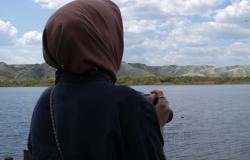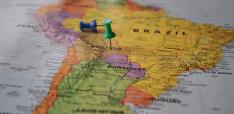Parched Politics: Iran’s Water Scarcity and the Rising Wave of Discontent

Shirin Hakim argues that water issues have the potential to mobilize a new wave of activism in the Republic.
Water has long shaped landscapes and civilizations. In the face of water scarcity, escalating concerns regarding the availability of this resource are forming new pathways for political change in the Middle East. With its increasingly arid climate and burgeoning political discontent, Iran stands as a quintessential case for examining the ramifications of water scarcity.
According to the Iranian Meteorological Organization, 97 percent of Iran is experiencing some degree of drought conditions. Although Iran’s water crisis continues to be made worse by the impacts of climate change, the main culprit of the decline of water resources in the country stems from decades of environmental mismanagement, corruption, and the prioritization of the economy over and above environmental concerns. As civil unrest in Iran continues, increased attention to water scarcity showcases the potential for water issues to channel discontent and give momentum to streams of political opposition.
Iran’s water crisis is casting ripples in local, regional, and international policy conversations. Recent water cuts in the capital, the decline of Lake Urmia, and growing tensions over the water rights to the Helmand River along the Iran-Afghanistan border illustrate the significance of water and environmental diplomacy in Iran’s future. A closer examination of each of these issues reveals the potential for water to act as a catalyst for change.
.png) As a result of Iran’s economic isolation, rapid population growth, urbanization, and prolonged drought the country has entered a critical state of water scarcity. The overexploitation of ground and surface water through ill-conceived dam and hydraulic constructions and water transference schemes has disrupted the natural flow of water and contributed to the desiccation of local bodies of water, dwindling groundwater reserves, and land subsidence.
As a result of Iran’s economic isolation, rapid population growth, urbanization, and prolonged drought the country has entered a critical state of water scarcity. The overexploitation of ground and surface water through ill-conceived dam and hydraulic constructions and water transference schemes has disrupted the natural flow of water and contributed to the desiccation of local bodies of water, dwindling groundwater reserves, and land subsidence.
This water scarcity has been worsened by the nation’s heavily inefficient agricultural sector, which accounts for nearly 90 percent of the country’s total water use, but only contributes to a meager 10 percent of the economy. Despite declining water availability and drought conditions, Iran’s agricultural sector has been pushed to expand to fulfil growing food demands and meet self-sufficiency schemes that have emerged as regime imperatives following the establishment of the Islamic Republic. These schemes have been promoted in an effort to insulate the country from the impacts of sanctions and volatilities in international markets.
At present, multiple effects of the water crisis are being felt across the country. Residents in the capital city, Tehran, reported days of consecutive water cuts in June and expressed their frustration on social media, sharing images and videos of citizens resorting to tankers for water resources. These frustrations are adding to growing discontent that has engulfed the country since September 2022 following the murder of Mahsa Amini and the emergence of the Women, Life, Freedom movement. As access to water becomes increasingly scarce in the region, the demand for water coincides with growing demands for regime change.
Outside of the capital city, water issues continue to demand attention. Lake Urmia, formerly revered as the largest saltwater lake in the Middle East, has now lost 95 percent of its original water volume. A myriad of factors has contributed to this decline including climate change, the construction of excessive dams to manipulate the flow of water, major infrastructural projects like the Shahid Kalantari highway that has divided the lake’s ecosystem in half, and the over-extraction of water for agricultural expansion. The shrinking of the lake has offset the balance of a once thriving ecosystem, leading to the gradual disappearance of native wildlife and subjecting surrounding communities to an increased risk of salt-storms. As heavy winds move over the desiccating lake, small particles of matter and salt enter the air contributing to declines in agricultural productivity and risks to human health. This has prompted growing migration from the region, as economic performance has declined. The decline of Lake Urmia exemplifies a broader trend affecting major wetlands throughout the country, including, but not limited to, Shadegan, Hoor Al-Azim, and Hamoun.
Iran’s water crisis has also exacerbated transboundary water disputes. There have been growing tensions between Iran and the Taliban over the water rights to the Helmand River, which flows from Afghanistan into Iran feeding the Hamoun wetlands, as evidenced by recent skirmishes. At the end of May 2023, a clash along the border resulted in the death of two Iranian border guards and one Taliban fighter. Iran claims Afghanistan has failed to fulfil its commitments under the 1973 treaty established between the two nations regarding water rights. In accordance with the treaty, Afghanistan agreed to allocate 850 million cubic meters of water to Iran from the Helmand River under normal conditions. The Helmand River is a vital resource of water for both countries, namely Iran's drought-stricken southeastern region of Sistan and Baluchistan, which has been disproportionately targeted since the onset of the Woman, Life, Freedom movement in September of 2022. This region is one of Iran’s poorest provinces and home to a significant number of agricultural communities that have been impacted by climate change and the mismanagement of water resources in the region. Attempts have been made to diffuse tension along this border, but it remains to be seen if diplomacy can solve this issue. Iran’s inability to address water scarcity has the potential to mobilize a broader base of citizens, including farmers in rural communities, who may not have expressed support for the Woman, Life, Freedom movement.
Despite water scarcity posing an escalating threat to the Islamic Republic, its leaders have shown little inclination towards progressive action and have remained largely reluctant to accept climate change science, frequently attributing Iran’s environmental decline to the impacts of sanctions or external forces. While sanctions have created impediments to Iran’s ability to sustainably develop in regard to technology exchange and in financing projects, the Islamic Republic continues to rely on antiquated and water-intensive irrigation methods, undervalues wastewater management, and has been resistant to implement the public education campaigns necessary to address the worsening water crisis. Moreover, the Islamic Republic’s scrutiny and imprisonment of environmental activists has made environmental advocacy nearly impossible. As Iranian leaders continue to downplay the severity of this water crisis, the likelihood of water becoming a catalyst for change increases.
In previous years, Iran has witnessed an increased frequency of protests relating to water shortages during the summer months. Local and transboundary water issues will continue to place pressure on the Islamic Republic with impacts that will worsen economic and social consequences and increase the likelihood that environmental issues converge with other streams of discontent. Given the continued failure of the regime to adopt systematic change and policy reform, water issues have the potential to mobilize a new wave of activism. As policy communities seek to seed the clouds of political transformation in Iran, attention to the importance of water is crucial to navigate the currents of public sentiment and contribute to a more sustainable and equitable political landscape in Iran’s future.
Dr. Shirin Hakim is a Senior Fellow at the Center for Middle East and Global Order (CMEG) and a Fellow at the Atlantic Council GeoEconomics Center https://twitter.com/ShirinHakim
Photo by Ayşenaz Bilgin


